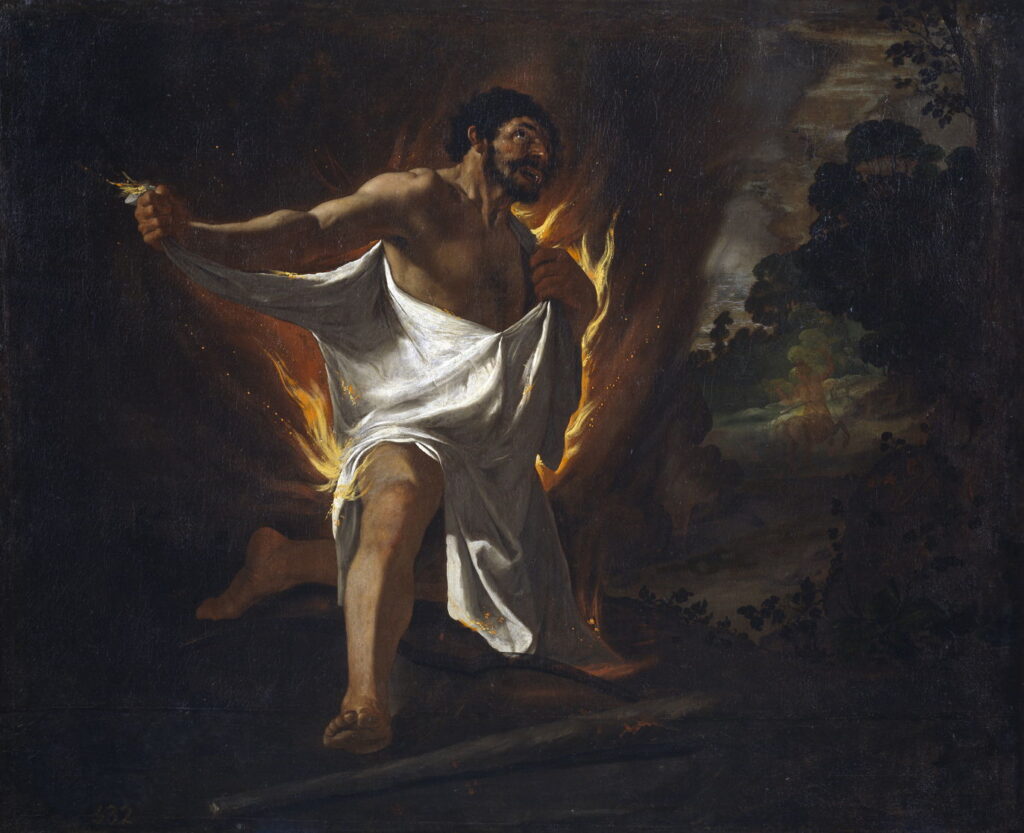Changing Paintings: 43 The death of Hercules

Once Achelous had completed telling the story of how his lost horn had been transformed into the Horn of Plenty, the floods had abated, so his guests left the banquet, leaving Ovid to explain the events leading to the death of the great hero Hercules. This reverses the chronological order, as the next story after that in Metamorphoses tells of his birth.
Having won her hand by defeating Achelous, Hercules married the beautiful Deianira, and was returning with her to his native city. The couple reached the River Euenus, which was still in spate from the winter’s rains. Hercules feared for his bride trying to cross the river, but the centaur Nessus came up and offered to carry her across.
Hercules had thrown his club and bow to the other bank and had swum across the river when he heard Deianira’s voice calling. He suspected Nessus was trying to abduct her, so shouted warning to him before loosing an arrow at the centaur’s back.
Ovid’s description of these events poses a problem for those trying to depict them, in choosing the right point of view and composition to remain faithful to that account.
Guido Reni (1575–1642), The Abduction of Deianeira (1617-21), oil on canvas, 239 x 193 cm, Musée du Louvre, Paris. Wikimedia Commons.
Guido Reni’s masterly painting from around 1620, one of the finest of its period in the Louvre, almost fills the canvas with Nessus, who looks worryingly heroic, and Deianeira, who seems to be flying. The small figure of Hercules in the distance is well-lit, but loses the details of bow and arrow. In any case, that arrow could hardly strike Nessus in the chest.
Paolo Veronese (1528–1588), Hercules, Deianira and the Centaur Nessus (c 1586), oil on canvas, 68.4 × 53.4 cm, Kunsthistorisches Museum, Vienna, Austria. Wikimedia Commons.
Paolo Veronese’s painting from about 1586 also elects for this early moment, as Hercules is readying his bow and arrow, with Nessus just reaching the opposite bank. He shows the scene from Hercules’ position, but discovers the problems with that point of view: Nessus and Deianeira are now small, and Nessus is looking away with his chest concealed, and even Hercules’ face is turned from the viewer. The result makes its hero look more like a furtive stalker.
Peter Paul Rubens (1577–1640) (workshop of), The Abduction of Deianeira by the Centaur Nessus (c 1640), oil on panel, 70.5 x 110 cm, Niedersächsisches Landesmuseum Hannover, Hanover, Germany. Wikimedia Commons.
This marvellous painting was probably made by Rubens’ workshop around the time of the Master’s death in 1640. It views the events from the bank on which Hercules is poised to shoot his arrow into Nessus. This has the centaur running across the width of the canvas, his face and body well exposed for Hercules’ arrow to enter his chest. To make clear Nessus’ intentions, a winged Cupid has been added, and Deianeira’s facial expression is clear in intent. An additional couple, in the right foreground, might be intended to be a ferryman and his friend, who appear superfluous apart from their role in achieving compositional balance.
Antonio del Pollaiolo (1431–1498), Hercules and Deianira (c 1475–80), oil on panel transferred to canvas, 54.6 × 79.2 cm, Yale University Art Gallery, New Haven, CT. Wikimedia Commons.
Antonio del Pollaiolo’s painting from about 1475–80 tries a side-on view, requiring Nessus to be shot while still in the river, in a slight adjustment to the original story. Deianeira appears precariously balanced, and must be grateful that Nessus’ muscular arms save her from being dropped into the river below. The artist also leaves it to the viewer to know that Hercules’ poisoned arrow strikes Nessus rather than Deianeira.
Louis-Jean-François Lagrenée (1724–1805), The Abduction of Deianeira by the Centaur Nessus (1755), oil on canvas, 157 × 185 cm, Musée du Louvre, Paris. Wikimedia Commons.
Three centuries later, Louis-Jean-François Lagrenée clearly understood the compositional problem, but didn’t arrive at such a good solution. Nessus, bearing a distressed Deianeira in his arms, has just reached the opposite bank, in the foreground. Hercules is on the left in the distance, and we can at least see his face, bow and arrow. There appears to be no way that Hercules’ arrow could impale Nessus’ chest, without first passing through some of the abundant Deianeira, nor his back. Lagrenée also adds a ferryman, who seems to have been knocked over in Nessus’ haste to make off with his captive.
Gustave Moreau (1826–1898), Enlèvement de Déjanire (Abduction of Deianeira) (c 1860), pen and brown ink wash on pencil on paper, 22.6 × 15.6 cm, Musée National Gustave-Moreau, Paris. Wikimedia Commons.
Gustave Moreau’s final drawing of about 1860, squared up and ready to transfer to canvas for painting, alters the story to make its composition feasible. He puts Nessus in the foreground, with the attendant risk of making him appear the hero, somehow supporting the upstretched body of Deianeira. In the right distance, Hercules has already loosed the fatal arrow, which is prominently embedded not in the front of Nessus’ chest, but in his back. The centaur’s legs have collapsed under him, and his head and neck are stretched up in the agony of death.
Gustave Moreau and Jules Élie Delaunay seem to have worked on a compositional solution together, resulting in Delaunay’s brilliant painting of 1870, which is sadly not available for use here.
That single shot ran Nessus through. He tore the arrow out, and his blood spurted freely, mixed with poison from the Lernaean hydra. Determined to avenge his own death, the centaur gave Deianira his tunic soaked with that poison, telling her to keep it to “strengthen waning love.”
Sebastiano Ricci (1659–1734), Hercules Fighting with the Centaur Nessus (1706-7), fresco, dimensions not known, Palazzo Marucelli-Fenzi, Florence. Wikimedia Commons.
In about 1706, Sebastiano Ricci embroidered this story further, showing Hercules, his left hand grasping Nessus’ mouth, about to club the centaur to death, while a slightly bedraggled Deianeira watches in the background. There’s no arrow in Nessus’ chest, and Hercules’ quiver is puzzlingly trapped under Nessus’ right foreleg. Three other figures of uncertain roles are at the right, and a winged putto hovers overhead, covering its eyes with its right hand.
Arnold Böcklin (1827–1901), Nessus and Deianira (1898), oil on panel, 104 x 150 cm, Museum Pfalzgalerie Kaiserslautern, Kaiserslautern, Germany.
In Arnold Böcklin’s puzzling painting from 1898, Nessus is far from part-human, and Deianeira isn’t the beauty she was claimed to be. As those two wrestle grimly, Hercules has stolen up behind them, and is busy pushing a spear into Nessus’ bulging belly. Blood pours from the wound, but Deianeira is in no position to collect it.
Years passed after Nessus’ death, and Hercules was away in Oechalia, intending to pay his respects to Jupiter at Cenaeum. Word reached Deianira that her husband had fallen in love there with Iole. Initially, she was upset, but then tried to devise a strategy to address his rumoured unfaithfulness. It was then that she recalled the blood of Nessus, and his dying words to her. She therefore impregnated a shirt with that blood, and gave that to Lichas, Hercules’ servant, to take to her husband.
Artist not known, Deianira Sends her Husband Hercules the Tunic Impregnated with the Blood of the Centaur Nessus (c 1510), miniature in Octavien de Saint-Gelais’ translation of Ovid’s Heroides (1496-1498), Folio 108v, Bibliothèque nationale de France, Paris. Wikimedia Commons.
This is shown in this beautiful miniature accompanying Octavien de Saint-Gelais’ translation of Ovid’s Heroides from about 1510.
Hercules donned the shirt as he was about to pray to Jupiter. He felt warmth spreading throughout his limbs, quickly growing into intense pain. Trying to tear the shirt off, he obtained no relief, and only ripped off his burnt skin from the burning flesh underneath. Hercules roamed through Oeta like a wounded beast, still trying to tear the shirt off his body. He came across Lichas, and accused him of being his murderer. His servant tried to protest his innocence, but Hercules picked him up, swung him around, and flung him out to sea, where he was transformed into a rock pinnacle.
Hercules then cut down trees and built himself a funeral pyre. Ordering this to be lit, he climbed on top, and lay back on his lionskin.
Master of the English Chronicle (dates not known), The Death of Hercules (c 1470), in Histoires de Troyes, illuminated manuscript by Raoul Le Fèvre, Bruges folio, Folio 233v, location not known. Wikimedia Commons.
This is illustrated in another miniature, The Death of Hercules (c 1470), this time for Raoul Le Fèvre’s Histoires de Troyes.
Francisco de Zurbarán (1598–1664), The Death of Hercules (1634), oil on canvas, 136 × 167 cm, Museo Nacional del Prado, Madrid, Spain. Wikimedia Commons.
Francisco de Zurbarán’s powerful Death of Hercules (1634) uses chiaroscuro as stark as any of Caravaggio’s to show a Christian martyrdom, with its victim staring up to heaven, commending his soul to God.
Jupiter came to the aid of the dying hero, calling on the gods to consent to Hercules being transformed into a god; they agreed, and his immortal form was carried away on a chariot drawn by four horses, into the stars above.
Giovanni Domenico Tiepolo (1727–1804), The Apotheosis of Hercules (c 1765), oil on canvas, 102 x 86 cm, Museo Thyssen-Bornemisza, Madrid, Spain. Wikimedia Commons.
Tiepolo’s wonderful Apotheosis of Hercules (c 1765) portrays this as a saintly ascension, which seems inappropriate.




